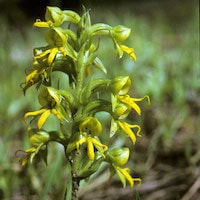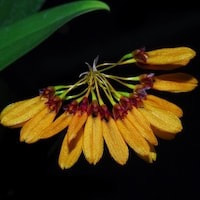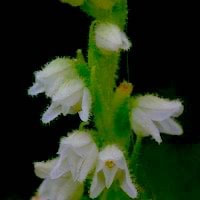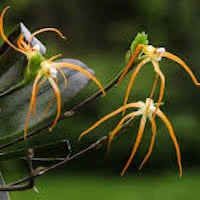MWD2- Men's Woody 2 - For lack of a pepper name
|
Native Singaporean Orchid notes: Gongora Quinquenervis
Gongora quinquenervis, an epiphytic orchid found in tropical forests up to 1000 meters high, grows in branching patterns and is admired for its ease of cultivation and impressive size. Its most notable feature is its sweet fragrance reminiscent of cinnamon, cloves, and lily-of-the-valley, due to compounds like Eugenol and Linalool. This orchid is prized in activities like the "Woody 2 (Men)" team-building perfume workshop for its scent and striking appearance, reflecting its cultural and ornamental significance in both natural habitats and human appreciation.
|
Therapeutic Orchid notes:
|
Habenaria marginata Colebr.
Habenaria marginata, known as the Golden Yellow Habenaria, is a small terrestrial orchid found from Pakistan to Thailand, including India, Bhutan, Nepal, and Bangladesh. It blooms with beautiful yellow flowers from July in India to November in various regions. In traditional medicine, it's valued for treating malignant ulcers in places like Orissa, India, and Bangladesh. In India's Sanjay National Park, its tubers are cooked as a vegetable. This orchid underscores local cultural knowledge and healing traditions, emphasizing the importance of preserving these practices for future generations. |
|
Bulbophyllum retusiusculum
Bulbophyllum retusiusculum, known as the Yellow Comb Orchid, is widely spread across China, Myanmar, Thailand, and other regions. In Thai traditional medicine, the entire plant is used to make a tonic valued for its health benefits, promoting vitality and overall well-being. This reflects local knowledge about plant medicines and their role in supporting health across generations. Preserving these practices not only sustains cultural heritage but also underscores the importance of conserving plant diversity for future medicinal uses and ecosystem health |
|
Goodyera R. Br.
Goodyera, known as "Banye Lan" in Chinese and "Shusu Ran" in Japanese, is a genus of orchids. In North America, they are called "rattlesnake plantain." These orchids rely on specific fungi for survival, forming a symbiotic partnership where fungi help them absorb nitrogen and other nutrients from the soil. This fungus-dependent process underscores the complex interactions between orchids and fungi in natural ecosystems, contributing to their ecological diversity and success worldwide over millions of years. |
|
Thrixspermum centipeda Lour.
Thrixspermum centipeda, known by multiple Thai names like "Kratai hu dieo" and "Ta khap lueang," is an epiphytic orchid with a broad range from Bhutan to Indonesia, flowering from June to September across regions. In Thai traditional medicine, the entire plant is used to manage asthma symptoms. Local healers value its medicinal properties, incorporating parts of the plant into herbal remedies. This use reflects deep local knowledge of plant resources, though caution and medical advice are advised for proper treatment of medical conditions. |
|
Vanilla aphylla Blume
Vanilla aphylla Blume, known by Thai names like "Khot nok kut" and "Khruea ngu khieo," is an orchid species with dark green, flattened stems found in southern Thailand, Myanmar, Indochina, northern Peninsular Malaysia, and Java. In Thai traditional medicine, its stem is used to treat liver issues. Local healers believe it has medicinal properties beneficial for liver dysfunction. While traditional remedies are valued, caution and medical consultation are recommended for safe treatment of medical conditions, ensuring sustainable use and conservation of wild plant resources. |
Other scent note
Scentopia Library Reference ingredient
Benzoin - Check details at Scentopia's scent library
Download the guided mediation that works best with this Orchid fragrance oil
| men_woody_essential_oil_orchi_00002.mp3 | |
| File Size: | 41154 kb |
| File Type: | mp3 |





